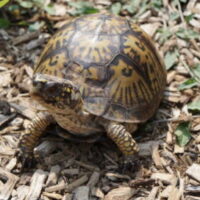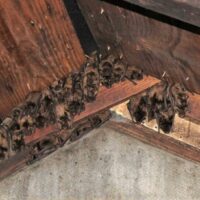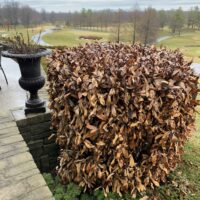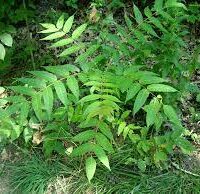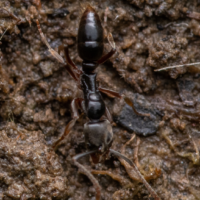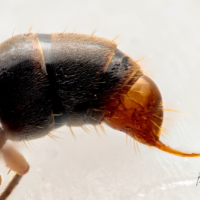 Purdue University - Extension - Forestry and Natural Resources
Purdue University - Extension - Forestry and Natural Resources
Got Nature? Blog
Wild Bulletin, Indiana Department of Natural Resources (DNR) Fish and Wildlife: The Eastern box turtle (Terrapene carolina) is a species of hinge-shelled turtle that lives on forested land in Indiana. Box turtles are long-lived, slow to mature and have few offspring per year. This, coupled with the high mortality rate of box turtles being hit on roads, has resulted in Eastern box turtles being a species of special concern in Indiana.
Eastern box turtles are listed as a species of special concern in Indiana due to population declines involving habitat loss, road mortality, and collection for pets. If you see one this summer, be sure to keep these guidelines in mind:
- Eastern box turtles may not be collected from the wild; however, if you accidentally catch an Eastern box turtle from Indiana from the wild, please contact the Division of Fish & Wildlife at DFW@dnr.IN.gov; do not release it into the wild. Its chances of survival are low, and it could transmit diseases to other wild Eastern box turtles.
- Sick or injured Eastern box turtles should be left in the wild. Don’t fret—box turtles are surprisingly resilient to damage and disease. If left alone, they will likely heal on their own. If a box turtle appears severely injured, it can be given to a licensed rehabilitator or licensed veterinarian.
If you see a wild Eastern box turtle crossing a busy road, you can pick it up and move it to the other side of the road in the direction it was facing. DNR appreciates your efforts to conserve wildlife.
To identify and learn more about the Eastern box turtle, please visit the DNR: Fish and Wildlife: Eastern Box Turtle website
Resources
Turtles of Indiana, The Education Store
Appreciating Reptiles and Amphibians in Nature, The Education Store
Forestry Management for Reptiles and Amphibians: A Technical Guide for the Midwest, The Education Store
The Nature of Teaching, Unit 3: Reptiles, Amphibians, and the Scientific Method, The Education Store
Partners in Amphibian and Reptile Conservation (PARC)
Ask An Expert, Purdue Extension – FNR Playlist
Indiana Department of Natural Resources
In this webinar, hosted by Indiana Forestry & Woodland Owners Association (IFWOA), presenter LeAnne Barta of Indiana Lyme Connect shares strategies for preventing tick bites and discuss the ticks found in Indiana, their life stages, and symptoms of tick-borne illnesses like Lyme disease.
Check out the Indiana Forestry & Woodland Association YouTube Channel for videos including: What is IFWOA?; A New Carbon Program for Hardwood Landowners Webinar, Indiana’s Native Orchids, Magnificent Trees of Indiana, Observing Seasonal Changes in Nature and much more.
The Indiana Forestry & Woodland Owners Association (IFWOA) was founded in 1977 and is a non-profit organization dedicated to conservation and sustainable management of woodlands in Indiana. IFWOA advocates for scientific best practices for management to achieve objectives of clean water, wildlife habitat, soil protection, native species diversity, timber production, recreation, carbon sequestration and many others.
IFWOA is an affiliate of the National Woodland Owners Association. IFWOA is a partner, collaborator or is represented on leading National and State organizations. These memberships or collaborations are selected to advance Indiana Woodland owner’s interests. IFWOA monitors and influences legislation and economic trends impacting Indiana woodlands and landowners for our members. Membership in IFWOA provides a valuable network linkage to information and resources at the leading edge of science, industry and politics impacting Indiana woodlands.
Resources:
Find an Indiana Professional Forester, Indiana Forestry & Woodland Owners Association (IFWOA)
Purdue Arboretum Explorer
Native Trees of the Midwest, The Education Store
Shrubs and Woody Vines of Indiana and the Midwest, The Education Store
Investing in Indiana Woodlands, The Education Store
Forest Improvement Handbook, The Education Store
ID That Tree, Purdue Extension-Forestry & Natural Resources (FNR) YouTube playlist
Woodland Management Moment , Purdue Extension-FNR YouTube playlist
Liz Jackson, Engagement Lead
Indiana Forestry & Woodland Association
MyDNR, Indiana’s Outdoor Newsletter: During the spring and summer please let us know if you think you may have seen spotted lanternfly by contacting us at 866-NO-EXOTIC (866-663-9684), or by email at DEPP@dnr.IN.gov. Please be sure to provide your contact information and detailed information about the location. Early detection is crucial to successful spotted lanternfly management efforts.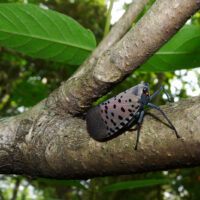
Spotted lanternfly is a major pest of concern across most of the United States. This insect is native to China and parts of India, Vietnam, Japan, and Taiwan. It was first identified as an invasive species in 2004 in South Korea and is now a major pest there. Spotted lanternfly was first detected in the United States in Pennsylvania in 2014.
In July 2021, a population of spotted lanternfly (Lycorma delicatula) was identified in Indiana in Switzerland County, near the Ohio River. A second population was found in Huntington, Indiana in July 2022. DEPP and USDA continue to conduct surveys to ascertain the extent and source of these infestations as well as determine what management strategies will be implemented.
Newsletter can be found online: MyDNR Email Newsletter
For more information please visit Spotted Lanterfly – MyDNR
Resources:
Spotted Lanternfly, Indiana Department of Natural Resources Entomology
Spotted Lanternfly Found in Indiana, Purdue Landscape Report
Invasive plants: impact on environment and people, The Education Store, Purdue Extension’s resource center
Woodland Management Moment: Invasive Species Control Process, Video, Purdue Extension – Forestry and Natural Resources (FNR) YouTube Channel
Invasive Species, Playlist, Purdue Extension – FNR YouTube Channel
What are invasive species and why should I care?, Got Nature? Blog, Purdue Extension – FNR
Report Invasive, Purdue College of Agriculture – Entomology
Indiana Department of Natural Resources, Department of Fish & Wildlife
MyDNR, Indiana’s Outdoor Newsletter: Do you have bats roosting on your property? Help DNR by counting how many bats fly out during a few evenings this summer. Monitoring bats as they emerge from roosts helps us manage the reproductive health of bats across the state.
The Summer Bat Roost Monitoring Project uses volunteers to collect information on the distribution, occupancy and abundance of bat colonies throughout Indiana.
Participants must have bats roosting on their property or permission to enter property where a roost occurs. Possible roost sites include trees, bat houses, barns, attics, outbuildings and other structures. On each night of surveying, volunteers count the bats that exit the roost and record weather information. Each survey takes about an hour and is conducted on eight to 12 nights from mid-May to mid-July.
Newsletter can be found online May: DNR: Communications: MyDNR Email Newsletter (in.gov)
For more information please visit Summer Bat Roost Monitoring Project.
To sign up for the project, visit the Division of Fish & Wildlife’s volunteer page and select “Find an ongoing service project.” Wildlife Diversity staff also monitor bats using mobile acoustic surveys and acoustic monitoring stations.
Resources:
Hardwood Ecosystem Experiment (HEE) Highlights: Bats, Video, Purdue Extension – Forestry and Natural Resources (FNR) YouTube Channel
Bats in the Belfry, Purdue Extension – FNR Got Nature? Blog
Ask An Expert: Bats on the Hardwood Ecosystem Experiment (HEE), Video, Purdue Extension – FNR Facebook
Bats in Indiana, Indiana Department of Natural Resources (IN DNR)
Bat Houses, Bat Conservation International
Creating a Wildlife Habitat Management Plan for Landowners, The Education Store, Purdue Extension’s resource center
The Hardwood Ecosystem Experiment (HEE): Indiana Forestry and Wildlife, The Education Store
Subscribe to Purdue Extension-FNR YouTube Channel
Indiana Department of Natural Resources, Department of Fish & Wildlife
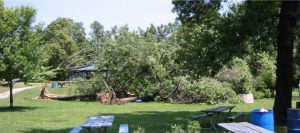 Safety first! Stay clear and look for dangerous hanging limbs, broken branches and other failures before beginning cleanup or inspections. Keep others clear of the areas beneath and around damaged trees. Be alert for power lines that could be involved with damaged trees. All utility lines should be considered energized and dangerous.
Safety first! Stay clear and look for dangerous hanging limbs, broken branches and other failures before beginning cleanup or inspections. Keep others clear of the areas beneath and around damaged trees. Be alert for power lines that could be involved with damaged trees. All utility lines should be considered energized and dangerous.
Lindsey Purcell, Chapter Administrator & Master Arborist with Indiana Arborist Association, shares, “in my experience, during storm cleanup, many tree owners are faced with the decision of what to do with their trees relative to restoration or removal”. There are several types of tree damage that occur from violent weather. Each has its own specific assessment considerations. All parts of the tree should be inspected during a post-storm assessment. This requires the expertise of trained, professional arborists to assist with the decision making regarding the best course of action. Unfortunately, there are those who take advantage of the situation and overcharge or provide poor advice when it comes to the best decision on their trees. Don’t make any hasty decisions and be sure you are hiring an International Society of Arboriculture (ISA) Certified Arborist, ask for references and proof of insurance in the process. To find an arborist near you, verify credentials and to find more information on trees view video: Find an Arborist, Trees are Good, ISA.
View publication Trees and Storms located in The Education Store, Purdue Extension’s resource center, for more information.
Resources:
Find an Arborist video, Trees are Good-International Society of Arboriculture (ISA)
Caring for storm-damaged trees/How to Acidify Soil in the Yard – In the Grow, Purdue Extension
Moist soil and rotten roots makes it easy for trees to come crashing down – Fox 59 News
Why Is My Tree Dying? – The Education Store
Tree Risk Management – The Education Store
Mechanical Damage to Trees: Mowing and Maintenance Equipment – The Education Store
Trees and Electric Lines – The Education Store
Indiana Prepared (IN-PREPared), Purdue Extension
Lindsey Purcell, Chapter Administrator & Master Arborist
Indiana Arborist Association
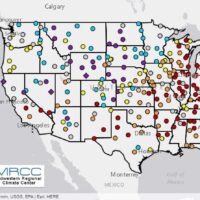
Figure 1. Accumulated Winter Season Severity Index for winter 2022-2023 in the United States from the Midwest Regional Climate Center.
Purdue Landscape Report: Remember the pre-Christmas freeze? What about the extremely long fall? The Midwest experienced above-average temperatures through most of the winter, but those extremely cold temps in late December made for more than a few pipes to freeze in the southern part of the Midwest. The dichotomy in weather patterns over the last several years has been mind-boggling. We’ve gone from flooding to drought in most recent growing seasons, to the extremes in temperatures this winter. Though it’s an inconvenience for us, plants don’t have the option of heated seats or umbrellas, thus stress or death can occur in these extremes.
East of the Mississippi River, the 2022-2023 winter has been significantly milder than average, based on past climate models (Fig. 1). We don’t typically have cold injury in late December, but drastic changes in temperatures can cause pernicious effects on plant health. The entire state of Indiana had the drastic changes in temperature December 22-27, 2022 (Table 1).

Table 1. The high and low temperatures (F) in Evansville, Indianapolis, and Fort Wayne December 22-27, 2022. Data courtesy of the National Weather Service.
There’s on-going evidence of damage across the Midwest from the late/long fall and extreme cold that was experienced in mid-late December. We’ve observed some perennial evergreens, i.e., American holly, Meserve holly (Fig. 2), and skip laurel (Fig. 3), damaged or killed during this winter, especially in the southern parts of the Midwest. In addition, some deciduous trees have significant bark cracking (Fig. 4). Though these plants are hardy well below the temperatures that were experienced, the maximum dormancy wasn’t yet reached by plants due to the warm temperatures so late into the winter season.
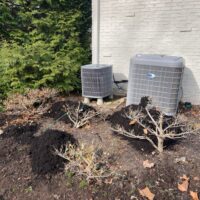
Figure 2. A planting of Meserve hollies died during the winter of 2022-2023 due to cold injury. Photo via Gabriel Gluesenkamp.
There’s on-going evidence of damage across the Midwest from the late/long fall and extreme cold that was experienced in mid-late December. We’ve observed some perennial evergreens, i.e., American holly, Meserve holly (Fig. 2), and skip laurel (Fig. 3), damaged or killed during this winter, especially in the southern parts of the Midwest. In addition, some deciduous trees have significant bark cracking (Fig. 4). Though these plants are hardy well below the temperatures that were experienced, the maximum dormancy wasn’t yet reached by plants due to the warm temperatures so late into the winter season.
Plants survive through the winter by entering a phase of dormancy in which the plant is in a state of suspended animation. The dormancy process in plants is a complicated series of internal events caused by external events, that allow perennial plants to protect themselves during environmental changes, such as winter.
For more images and full article view: Cold Injury During a Very Mild Winter?
Resources:
The Purdue Landscape Report
Purdue Landscape Report Facebook Page
Fall webworms: Should you manage them, Got Nature? Blog
Purdue Landscape Report Team Begins New Virtual Series, Got Nature? Blog, Purdue Extension – Forestry and Natural Resources (FNR)
Tree wounds and healing, Got Nature? Blog
Shrubs and Woody Vines of Indiana and the Midwest, The Education Store
Tree Risk Management, The Education Store
Why Is My Tree Dying?, The Education Store
ID That Tree, Purdue Extension-Forestry & Natural Resources (FNR) YouTube playlist
Subscribe to Purdue Extension-Forestry & Natural Resources (FNR) YouTube Channel
Kyle Daniel, Commercial Landscape and Nursery Crops Extension Specialist
Purdue Horticulture & Landscape Architecture
The precipitous decline in songbird numbers over the past few decades has made national news and generated calls for action to address the issues contributing to this decline. One of the contributing factors to the decline of several North American bird species is the diminishing area of suitable habitat.
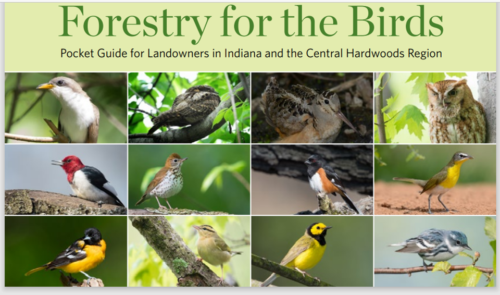 The initial assumption that many people have is this loss of habitat is forests or grasslands being converted into cropland or developments. While this does happen and is a concern in some areas, Indiana has actually been increasing our area of forest over the last several decades. An increasingly common habitat threat to several bird species is changing grassland or forest structure that occur through time in the absence of historic disturbances like fires or land management activities like thinning and harvesting.
The initial assumption that many people have is this loss of habitat is forests or grasslands being converted into cropland or developments. While this does happen and is a concern in some areas, Indiana has actually been increasing our area of forest over the last several decades. An increasingly common habitat threat to several bird species is changing grassland or forest structure that occur through time in the absence of historic disturbances like fires or land management activities like thinning and harvesting.
The invasion of forests, wetlands, and grasslands by invasive plant species can also degrade or destroy habitat values for birds and other wildlife. Managing areas to reduce invasive species and introducing disturbances like prescribed fires, critical area plantings, thinning, and regeneration activities can improve habitat quality for a variety of declining birds.
The The Nature Conservancy in Indiana, partnering with birders, ornithologists, foresters, and wildlife biologists, has developed the Forestry for the Birds program, modeled from a similar program in Vermont. The goal is to provide strategies that can benefit both forest management and bird communities, facilitating and simplifying the management of bird-friendly forests. “The Birders Dozen” were selected among declining birds that Indiana residents could identify by sight or song and need conservation action through habitat management.
Learn more about Forestry for the Birds, the Birders Dozen, and what you can do to help declining birds and other wildlife in Indiana. Find the Forestry for the Birds Pocket Guide which is a free download.
Resources:
Managing Woodlands for Birds Video, Purdue Extension-Forestry and Natural Resources (FNR) YouTube Channel
Breeding Birds and Forest Management: the Hardwood Ecosystem Experiment and the Central Hardwoods Region, The Education Store
The Birders’ Dozen, Profile: Baltimore Oriole, Indiana Woodland Steward
Ask An Expert, Playlist, Purdue Extension – FNR YouTube channel
It’s For the Birds, Indiana Yard and Garden-Purdue Consumer Horticulture
Birds and Residential Window Strikes: Tips for Prevention, The Education Store, Purdue Extension resource center
No Room at the Inn: Suburban Backyards and Migratory Birds, Education Store, Purdue Extension resource center
Hardwood Ecosystem Experiment – Wildlife Responses to Timber Harvesting, The Education Store
Subscribe, Purdue Extension – FNR YouTube Channel
Lenny Farlee, Sustaining Hardwood Extension Specialist
Purdue University Department of Forestry and Natural Resources
Jessica Outcalt, Agricultural & Natural Resources Educator
Purdue University Department of Forestry and Natural Resources
The Nature Conservancy – Indiana
 Spotted lanternfly is a major pest of concern across most of the United States. Spotted lanternfly (SLF) is an invasive planthopper native to China that was first detected in the United States in Pennsylvania in 2014. SLF feeds on over 70+ plant species including fruit, ornamental and woody trees with tree-of-heaven as its preferred host. Spotted lanternfly is a hitchhiker and can easily be moved long distances through human assisted movement.
Spotted lanternfly is a major pest of concern across most of the United States. Spotted lanternfly (SLF) is an invasive planthopper native to China that was first detected in the United States in Pennsylvania in 2014. SLF feeds on over 70+ plant species including fruit, ornamental and woody trees with tree-of-heaven as its preferred host. Spotted lanternfly is a hitchhiker and can easily be moved long distances through human assisted movement.
Tree of heaven (TOH) is the preferred host for the spotted lanternfly (SLF). The ability to identify TOH will be critical to monitoring the spread of this invasive pest as the 4th-stage nymphs and adult spotted lantern-flies show a strong preference for TOH.
Report a Sighting
- Take a picture and note your location.
- If you can, collect a sample of the insect by catching it and placing it in a freezer. You can use any container available as long as it has a tight seal (like a water bottle) so that the spotted lanternfly can’t escape.
- Report the sighting at DEPP@dnr.in.gov, eddmaps.org, or 1-866-663-9684.
- Check your car and outdoor equipment for spotted lanternfly eggs, nymphs, and adults before driving or moving to a new location.
- Don’t move firewood because it can spread spotted lanternfly and many other invasive insects.
- Stay up to date with the latest spotted lanternfly information by subscribing to our newsletters (www.purduelandscapereport.org/ and www.in.gov/dnr/entomology/entomology-weekly- review/) and following us on Facebook, Twitter, and Instagram (@reportINvasive and @INdnrinvasive).
- Share your spotted lanternfly knowledge with others!
Resources:
Spotted Lanternfly, Indiana Department of Natural Resources Entomology
Spotted Lanternfly Found in Indiana, Purdue Landscape Report
Invasive plants: impact on environment and people, The Education Store, Purdue Extension’s resource center
Woodland Management Moment: Invasive Species Control Process, Video, Purdue Extension – Forestry and Natural Resources YouTube Channel
Invasive Species, Playlist, Purdue Extension – FNR YouTube Channel
What are invasive species and why should I care?, Got Nature? Blog, Purdue Extension – Forestry and Natural Resources
Report Invasive
Diana Evans, Extension and Web Communication Specialist
Purdue University Department of Forestry and Natural Resources
It is official. The Asian needle ant is our newest invasive insect pest and has now become a permanent resident, stinging ant. Two ant specimens taken from a wooded area in southern Indiana by an astute amateur entomologist, who observed their appearance and behavior as ‘out of the ordinary’, was submitted to the Indiana Department of Natural Resources and to the Purdue University Plant and Pest Diagnostic Laboratory for species identification in February, 2022. Both were confirmed to be Formicidae: Brachyponera chinensis, commonly known as the Asian needle ant, not previously recorded from Indiana.
Asian needle ants (ANAs), originally from Eastern Asia (China, Japan, and Korea), were first discovered in the United States in the early 1930s, but only recognized as a pest since 2006. They have been officially established in several states in the U.S. including North Carolina, South Carolina, Alabama and Georgia and, have been anecdotally reported as far north and west as New York, Tennessee and Kentucky.
Note that stings to humans will be moderately painful (potentially causing severe allergic reactions to susceptible individuals) much like fire ant or bee stings, but fortunately because these ants are much less aggressive in protecting their nests, the number of stings per encounter will be less.
The First Report of the Invasive Asian Needle Ant in Indiana pdf provides more details on their identification and biology.
If you want to confirm a sighting of the Asian needle ant please contact the Purdue University Plant and Pest Diagnostic Laboratory at this time. More information will be presented as experts monitor the spread.
Resources:
Thousand Cankers Disease, collaborative website
Thousand Cankers Disease, Indiana Department of Natural Resources
Thousand Cankers Disease: Indiana Walnut Trees Threatened, The Education Store, Purdue Extension’s resource center
Indiana Walnut Council
Spotted lanternfly: Everything You Need to Know in 30 Minutes, Video, Emerald Ash Borer University
Emerald Ash Borer, EAB Information Network
Report Invasive Species, Purdue Invasive Species
The GLEDN Phone App – Great Lakes Early Detection Network
EDDMaps – Early Detection and Distribution Mapping System
Indiana Department of Natural Resources: Invasive Species
Indiana Invasive Species Council
Cooperative Invasive Species Management Area (CISMA)
Invasive plants: impact on environment and people, The Education Store
Woodland Management Moment: Invasive Species Control Process, Video, Purdue Extension – Forestry and Natural Resources (FNR) YouTube Channel
Invasive Species, Playlist, Purdue Extension – FNR YouTube Channel
What are invasive species and why should I care?, Got Nature? Blog, Purdue Extension – Forestry and Natural Resources
Report Invasive
Indiana Department of Entomology and Plant Pathology
Tim Gibb, Insect Diagnostician and Extension Specialist
Purdue Department of Entomology
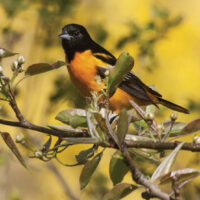 Question: Is there any risk of becoming infected with highly pathogenic avian influenza virus by feeding backyard birds or cleaning a bird feeder?
Question: Is there any risk of becoming infected with highly pathogenic avian influenza virus by feeding backyard birds or cleaning a bird feeder?
Answer: There is currently no evidence that suggests you could become infected with highly pathogenic avian influenza virus by feeding backyard birds. Generally, songbirds, or perching birds, (Passeriformes) are the primary type of birds at feeders, and they are usually not affected by HPAI. Most wild birds traditionally associated with avian influenza viruses are waterfowl, shorebirds and scavengers. It is unlikely that bird feeders will contribute to an outbreak among songbirds, but if someone also has backyard poultry, then we recommend removing bird feeders during the outbreak. Songbirds are susceptible to other avian diseases. Therefore, we recommend that people without backyard poultry who feed birds routinely, clean their feeders and bird baths, and anyone who comes in direct contact with bird droppings should thoroughly wash their hands with soap and water.
Additional information:
Indiana Department of Natural Resources (IN DNR) – Fish and Wildlife, Avian Flu: What is the risk to people? Very few types of AI can infect humans. The Centers for Disease Control and Prevention (CDC) considers the risk to people from AI viruses to be low. To date, no human AI infections have been detected in the United States. The U.S. has a strong AIV surveillance program that has been in place for many years.
Cornell Bird Lab: Avian Influenza Outbreak: Should You Take Down Your Bird Feeders?
Utah Division of Wildlife Resources: Is there any risk of becoming infected with highly pathogenic avian influenza virus by feeding backyard birds or cleaning a bird feeder?
Resources:
The National Audubon Society
Birds and Residential Window Strikes: Tips for Prevention, The Education Store, Purdue Extension resource center
Breeding Birds and Forest Management: the Hardwood Ecosystem Experiment and the Central Hardwoods Region, The Education Store
Putting a Little Wildlife in Your Backyard This Spring, The Education Store
It’s For the Birds, Indiana Yard and Garden-Purdue Consumer Horticulture
Managing Woodlands for Birds Video, Purdue Extension-Forestry and Natural Resources YouTube Channel
Brian MacGowan, Wildlife Extension Specialist
Purdue Forestry and Natural Resources
Recent Posts
- Report Spotted Lanternfly – Purdue Landscape Report
Posted: April 10, 2024 in Alert, Forestry, Invasive Insects, Plants, Wildlife, Woodlands - Declining Pines of the White Variety – Purdue Landscape Report
Posted: in Alert, Disease, Forestry, Plants, Wildlife, Woodlands - Are you seeing nests of our state endangered swan? – Wild Bulletin
Posted: April 9, 2024 in Alert, Forestry, How To, Wildlife - 2024-25 Fishing Guide now available – Wild Bulletin
Posted: April 4, 2024 in Alert, Aquaculture/Fish, Aquatic/Aquaculture Resources, How To, Ponds, Wildlife - Look Out for Invasive Carp in Your Bait Bucket – Wild Bulletin
Posted: March 31, 2024 in Alert, Aquaculture/Fish, Aquatic/Aquaculture Resources, Invasive Animal Species, Wildlife - Rare Cicada Emergence: Q&A with Purdue Bug Expert
Posted: March 25, 2024 in Alert, Forestry, Plants, Safety, Wildlife - State of Indiana Proclamation-Invasive Species Week 2024
Posted: February 19, 2024 in Alert, Forestry, Forests and Street Trees, Invasive Animal Species, Invasive Insects, Invasive Plant Species, Urban Forestry, Wildlife, Woodlands - Report Your Mudpuppy Observations to Indiana DNR – Wild Bulletin
Posted: February 1, 2024 in Alert, Aquaculture/Fish, Aquatic/Aquaculture Resources, How To, Wildlife - Learn About Lead: Avoiding Lead Ingestion in Wild Game, Wild Bulletin
Posted: December 8, 2023 in Alert, Disease, How To, Safety, Wildlife - Invasive Carp Removal on the Ohio River, Wild Bulletin
Posted: in Alert, Aquaculture/Fish, Aquatic/Aquaculture Resources, Invasive Animal Species, Wildlife
Archives
Categories
- Alert
- Aquaculture/Fish
- Aquatic/Aquaculture Resources
- Ask the Expert
- Christmas Trees
- Community Development
- Disease
- Drought
- Forestry
- Forests and Street Trees
- Gardening
- Got Nature for Kids
- Great Lakes
- How To
- Invasive Animal Species
- Invasive Insects
- Invasive Plant Species
- Land Use
- Natural Resource Planning
- Nature of Teaching
- Plants
- Podcasts
- Ponds
- Publication
- Safety
- Timber Marketing
- Uncategorized
- Urban Forestry
- Webinar
- Wildlife
- Wood Products/Manufacturing
- Woodland Management Moment
- Woodlands
